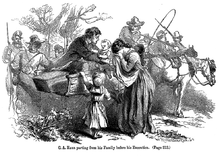Christopher Haun

Christopher Alexander "Alex" Haun (September 14, 1821 – December 11, 1861) was a potter from Greene County, Tennessee, regarded as one of the most notable and skilled of the antebellum period.[1][2][3][4] During the American Civil War, he was executed by the Confederate States of America for participation in the East Tennessee bridge-burning conspiracy.
Haun was one of many examples in 19th century Tennessee of what were later referred to as family potters, rural potters who ran businesses, often part-time as a supplement to farming and with the aid of their families, supplying practical vessels for local use.[5] Stephen T. Rogers of the Tennessee Historical Commission writes that Haun "produced some of the most beautiful and finely crafted lead-glazed earthenware in Tennessee".[2] Haun and a number of potters lived in a part of Greene County referred to as Pottertown, using local clay found near Lick Creek. Pottertown was a staunchly Unionist enclave in a Confederate State.[1][3]
Union supporter Reverend William Blount Carter launched a plan, with the approval of President Abraham Lincoln, to destroy Tennessee bridges in order to disrupt the Confederate railroad system. Haun and other local potters were recruited to destroy the bridge over Lick Creek. On November 8, 1861, after being sworn into Company F of the 2nd Regiment Tennessee Volunteer Infantry, they proceeded to the bridge and destroyed it. There they captured Confederate sentries and released them after they swore an oath to the union. The Confederate soldiers, however, informed the authorities and Haun and four others were captured. Haun and three of the others were hanged at the Knoxville, Tennessee jail on December 11.[1][3]
Before he died, he wrote to his wife regarding the disposition of his pottery business and concluded:
I have the promise that my body will be sent home to you.
O live for heaven,
Oh my bosom friend and children,
Live for heaven I pray.
My time is almost out, dear friend, farewell to this world — farewell to earth and earthly troubles.[1][2]
- ^ Cite error: The named reference
sgbwas invoked but never defined (see the help page).- ^ Cite error: The named reference
RogersHTAwas invoked but never defined (see the help page).
References
- 1 2 3 Hickman, Sarah Elizabeth (January 4, 2010). "Christopher Alexander Haun (1821-1861)". Tennessee Encyclopedia of History and Culture. Retrieved December 18, 2012.
- 1 2 Rogers, Stephen T. "Christopher Haun". Shades of Grey and Blue. Retrieved December 18, 2012.
- 1 2 3 Donahue Bible (30 September 2004). "Christopher Alexander Haun". In Carroll Van West. A history of Tennessee arts: creating traditions, expanding horizons. University of Tennessee Press. p. 218. ISBN 978-1-57233-239-3. Retrieved 18 December 2012.
- ↑ Stephen T. Rogers; Samuel D. Smith (23 October 2003). "Pottery". In Benjamin Hubbard Caldwell; Robert H. Hicks; Mark Scala. Art of Tennessee. Frist Center for the Visual Arts (Nashville, Tenn.) distributed by The University of Tennessee Press for the Frist Center for the Visual Arts. pp. 110–111. Retrieved 18 December 2012.
- ↑ Stephen T. Rogers (30 September 2004). "Jugs, Jars, Bowls, and Churns: Tennessee's Ceramic Crafts and Potters". In Carroll Van West. A history of Tennessee arts: creating traditions, expanding horizons. University of Tennessee Press. pp. 215–227. ISBN 978-1-57233-239-3. Retrieved 18 December 2012.